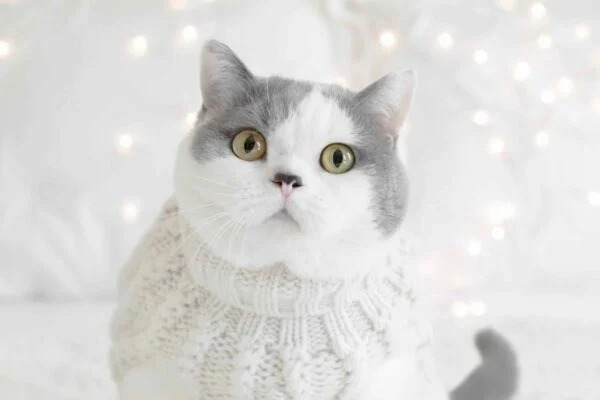Expert-Review, Cat
My cat is vomiting foam. Is it serious?
Your cat is vomiting foam? Don’t worry Guillaume, vomiting foam is not necessarily serious.
There are several causes for this phenomenon, ranging from hairballs to more serious health issues such as gastritis.
The key as a cat owner is to pay attention to your pet’s possible symptoms and consult a veterinarian if in doubt.
This is especially true if your cat is continually vomiting foam or stops eating.
We explain everything you need to know about a cat vomiting foam and what to do.
My cat vomits foam: origin of the color
My cat is vomiting white foam
White foam in a cat’s vomit can come from several sources.
Excessive saliva: When a cat vomits, it may produce a large amount of saliva in response to an emetic stimulus, which is a trigger for vomiting. This saliva may mix with other stomach contents and be expelled as foam.
Stomach upset: When a cat’s stomach is irritated, it may contract excessively, causing foam to form in the vomit. This can happen for a variety of reasons, such as eating too quickly, indigestion, or other gastrointestinal upset.
Lack of solid food: If a cat vomits after not eating solid food for a while, the white foam may simply be saliva and gastric mucus. This can happen when the cat has an empty stomach, but the stomach is still producing juices in preparation for digestion.
My cat is vomiting yellow foam
Just like white foam, yellow foam can have various origins.
Gastric secretions: Yellow foam may be the result of normal gastric secretions that cats produce to aid in digestion. When your cat vomits, these secretions may be expelled as yellow foam.
Bile: Bile is produced by the liver and stored in the gallbladder before being released into the intestine to help digest fats. If your cat has an empty stomach, there may be bile in the vomit, which can give it a yellow color.
Gastrointestinal Illness: In some cases, yellow foam in your cat’s vomit may be a sign of gastrointestinal illness, such as gastritis, gastroenteritis, or other digestive disorders. In such cases, it is important to consult a veterinarian for proper diagnosis and treatment.
My cat is vomiting green foam
Although green foam can have some of the same origins as yellow and white foam (bile, gastric secretion, gastrointestinal disease, etc.), it can also have others such as:
Diet: If your cat has recently eaten grass or plants, this can also cause green foam in their vomit. Some cats eat grass to help regulate their digestion or purge, and grass can cause green foam in their vomit.
My cat is vomiting clear liquid
The clear liquid can have certain origins similar to the white, yellow or green foam (regurgitation, gastroenteritis, etc.) but also:
Hairballs: Cats spend a lot of time grooming and licking themselves, which can lead to hairballs building up in their stomachs. When these hairballs become too large, your cat may expel them through vomiting, usually as a clear liquid mixed with mucus. The hairs are then visible.
My cat vomits brown
The brown color of your cat’s vomit can be caused by several factors.
Presence of digested blood: If your cat’s vomit contains digested blood, it may appear brown or black in color. Blood can come from different parts of your cat’s gastrointestinal tract, such as the stomach or intestines, and can be caused by a variety of conditions, such as ulcers, infections, tumors, or blood clotting disorders.
Presence of bile: If your cat’s vomit contains bile, it may give it a brownish-green color. This could be due to a problem with the gallbladder emptying, stomach irritation, or other gastrointestinal conditions.
Diet: The color of the food your cat ate can also affect the color of their vomit. If your cat ate dark-colored food, such as brown kibble or dark pâté, this can cause their vomit to appear brown. A cat that ate too quickly may regurgitate their undigested food within minutes.
Why is my cat vomiting white foam?
1. Hairball
One of the most common causes of a cat vomiting white foam is a hairball that your feline would like to expel.
Hairballs are created when cats groom themselves and end up swallowing their hair.
They may be able to pass them naturally through the stool, but some of them get stuck and have to come out another way. When they accumulate in the stomach, they are called “trichobezoars”.
It is therefore possible that your cat will initially vomit foam before vomiting the hairball that is bothering it.
2. Change of diet
A sudden change in diet can cause digestive problems including vomiting.
Some animals vomit when they fast for too long due to too much acid in their stomach.
3. Gastritis
Gastritis, which is an inflammation of the stomach, can cause vomiting in cats. The white foam you see may be mucus produced by the irritated stomach lining.
4. Food intolerance
Some cats may have a food intolerance to certain types of food, which can cause them to vomit white foam in reaction to the offending food.
5. Stress
Cat stress can also cause foamy vomiting, including white foamy vomiting.
6. Chronic Inflammatory Bowel Disease (IBD)
This condition can cause irritation of the colon in cats, which can lead to vomiting of white foam as well as other gastrointestinal symptoms such as diarrhea.
7. Ingestion of foreign objects
Cats can ingest foreign objects such as pieces of plastic, rubber, or other materials, which can cause stomach irritation and vomiting of white foam.
8. Allergic reaction
Some cats may develop allergic reactions to substances in their environment, food, or medication, which can result in vomiting white foam.
9. Pancreatitis
A cat that vomits white foam may be suffering from this problem.
Pancreatitis can occur acutely or chronically.
Pancreatitis may be associated with other diseases, such as gastrointestinal disorders, liver disease and/or diabetes.
It involves inflammation or swelling of the pancreas, an organ responsible for producing enzymes needed for digestion and insulin needed to metabolize sugar.
Signs of this disease include vomiting (sometimes accompanied by foam), diarrhea, and thinning of the coat.
Pancreatitis is a serious disease that must be diagnosed by a veterinarian who will be able to implement appropriate treatment.
10. Liver failure
Hepatitis and other liver conditions can cause vomiting in cats.
The liver performs important functions such as removing waste.
Failure to function properly will cause symptoms such as vomiting foam, loss of appetite and/or weight loss.
In more advanced cases, yellowing of the mucous membranes and skin may occur, called jaundice or icterus.
Several diseases, toxins or tumors can affect the liver.
11. Diabetes
Diabetes can also explain why your cat is vomiting white foam, but other symptoms will also be present.
Diabetes in cats is characterized by insufficient production of insulin, the hormone that allows glucose to enter cells.
Without insulin, glucose builds up in the blood and symptoms appear.
If your cat has diabetes, you will notice that he is drinking, eating and urinating more.
Even if your cat isn’t gaining weight, you may also notice that he’s vomiting foam, has changes in his coat, and has bad breath. Veterinarian Dr. Berg talks to us about diabetes in cats in pictures.
12. Renal failure
A cat that vomits white foam may be suffering from kidney failure.
Kidney failure is a very common disorder in older cats.
Kidney damage can occur acutely or chronically.
It is essential to consult your veterinarian immediately if you notice signs such as a significant increase in water consumption, changes in urination, loss of appetite, dehydration, unhealthy coat, moodiness, weakness, mouth injuries, bad breath, or vomiting.
Acute cases require urgent veterinary consultation.
13. Hyperthyroidism
Hyperthyroidism can be the cause of a cat vomiting foam.
The thyroid gland is located in the neck and is responsible for the production of thyroxine. Hyperthyroidism occurs in cats over 10 years of age.
Signs of hyperthyroidism include weight loss, significant increase in activity (notice the cat not stopping), increased food and water intake, diarrhea, increased urination, and excessive vocalizations.
14. Parasites
If your cat is vomiting white foam and you have not dewormed him , he may be infested with internal parasites.
In this case, he may also be subject to diarrhea and stop eating.
All these inconveniences are caused by the action of parasites.
This situation is more likely to occur in kittens than in adults, because they are less resistant to parasites.
15. Taking medication
If your cat is taking medication regularly and vomits shortly after taking it, this may indicate an adverse reaction to the medication and you should consult your veterinarian for advice.
16. Intoxication
Ingesting toxic plants, chemicals, or any other toxic element can cause cats to vomit white foam.


